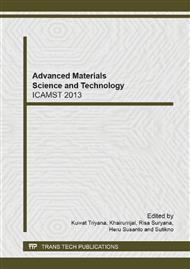[1]
D.H. Kim, H. Jeon, G. Kim, S.H. Wangboe, V.P. Verma, W. Choi, M. Jeon, Comparison of the optical properties of undoped and Ga-doped ZnO thin films deposited using rf magnetron sputtering at room temperature, Optic Communications. 281 (2008).
DOI: 10.1016/j.optcom.2007.12.015
Google Scholar
[2]
A. Barker, S. Crowther, D. Rees, Room temperature rf magnetron sputtered ZnO for electromechanical devices, Sensors and Actuators A. 58 (1997) 229-235.
DOI: 10.1016/s0924-4247(96)01430-6
Google Scholar
[3]
M.S. Tokumoto, A. Smith, C.V. Santilli, S. H. Pulcinelli, A.F. Craievish, E. Elkaim, A. Traverse, V. Briois, Structural electrical and optical properties of undoped and indium doped ZnO thin films prepared by pyrosol prosess at different temperatures, Thin Solid Films. 416 (2002).
DOI: 10.1016/s0040-6090(02)00531-x
Google Scholar
[4]
P. Marwoto, Sugianto, E. Wibowo, Growth of europium-doped gallium oxide (Ga2O3: Eu) thin films deposited by homemade DC magnetron sputtering, Journal of Theoritical and Applied Physics. 6 (2012) 17.
DOI: 10.1186/2251-7235-6-17
Google Scholar
[5]
M. Nafees, W. Liaqut, S. Ali, M.A. Shafique, Synthesis of ZnO/Al: ZnO Nanomaterial: Structural and band gap variation in ZnO nanomaterial by Al doping, Applied Nanoscience, 2 (2012) 284-293.
DOI: 10.1007/s13204-012-0067-y
Google Scholar
[6]
C. Suryanarayana & M.G. Norton, X-ray Diffraction A Practical Approach, Plenum Press, New York (1998).
Google Scholar
[7]
K. Postava, H. Sueki, M. Aoyama, T. Yamaguchi, K. Murakami, Y. Igasaki, Doping effects on optical properties of epitaxial ZnO layers determined by spectroscopic ellipsometry, Applied Surface Science. 175 (2001) 543-548.
DOI: 10.1016/s0169-4332(01)00145-3
Google Scholar
[8]
T. Sahoo, L. W. Jang, J. W. Jeon, M. Kim, J. S. Kim, I.H. Lee, Photoluminescence properties of zno thin films grown by using the hydrothermal technique, Journal of the Korean Physical Society. 56 (2010) 809-812.
DOI: 10.3938/jkps.56.809
Google Scholar
[9]
X. Bie, J.G. Lu, L. Gong, L. Lin, B.H. Zhao, Z.Z. Ye, Transparent conductive ZnO: Ga films prepared by dc magnetron sputtering at low temperature, Applied surface science. 256 (2009) 289-293.
DOI: 10.1016/j.apsusc.2009.08.018
Google Scholar
[10]
W. Gao, Z. Li, ZnO thin films produced by magnetron sputtering, Ceramics Inter. 30 (2004) 1155-1159.
DOI: 10.1016/j.ceramint.2003.12.197
Google Scholar


